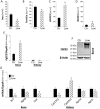Inflammation and functional iron deficiency regulate fibroblast growth factor 23 production
- PMID: 26535997
- PMCID: PMC4854810
- DOI: 10.1038/ki.2015.290
Inflammation and functional iron deficiency regulate fibroblast growth factor 23 production
Abstract
Circulating levels of fibroblast growth factor 23 (FGF23) are elevated in patients with chronic kidney disease (CKD), but the mechanisms are poorly understood. Here we tested whether inflammation and iron deficiency regulate FGF23. In wild-type mice, acute inflammation induced by single injections of heat-killed Brucella abortus or interleukin-1β (IL-1β) decreased serum iron within 6 h, and was accompanied by significant increases in osseous Fgf23 mRNA expression and serum levels of C-terminal FGF23, but no changes in intact FGF23. Chronic inflammation induced by repeated bacteria or IL-1β injections decreased serum iron, increased osseous Fgf23 mRNA, and serum C-terminal FGF23, but modestly increased biologically active, intact FGF23 serum levels. Chronic iron deficiency mimicked chronic inflammation. Increased osseous FGF23 cleavage rather than a prolonged half-life of C-terminal FGF23 fragments accounted for the elevated C-terminal FGF23 but near-normal intact FGF23 levels in inflammation. IL-1β injection increased Fgf23 mRNA and C-terminal FGF23 levels similarly in wildtype and Col4a3(ko) mice with CKD but markedly increased intact FGF23 levels only in the CKD mice. Inflammation increased Fgf23 transcription by activating Hif1α signaling. Thus, inflammation and iron deficiency stimulate FGF23 production. Simultaneous upregulation of FGF23 cleavage in osteocytes maintains near-normal levels of biologically active, intact circulating FGF23, whereas downregulated or impaired FGF23 cleavage may contribute to elevated intact serum FGF23 in CKD.
Keywords: FGF23; anemia; bone; hypoxia; inflammation; mineral metabolism.
Copyright © 2015 International Society of Nephrology. Published by Elsevier Inc. All rights reserved.
Conflict of interest statement
Figures







References
-
- David V, Quarles LD. Chapter 42 - FGF23/Klotho New Regulators of Vitamin D Metabolism. In: Adams, F D, P WS, editors. Vitamin D. Third. Academic Press; San Diego: 2011. pp. 747–761.
-
- Gutierrez O, Isakova T, Rhee E, et al. Fibroblast growth factor-23 mitigates hyperphosphatemia but accentuates calcitriol deficiency in chronic kidney disease. Journal of the American Society of Nephrology : JASN. 2005;16:2205–2215. - PubMed
Publication types
MeSH terms
Substances
Grants and funding
LinkOut - more resources
Full Text Sources
Other Literature Sources
Medical
Research Materials

